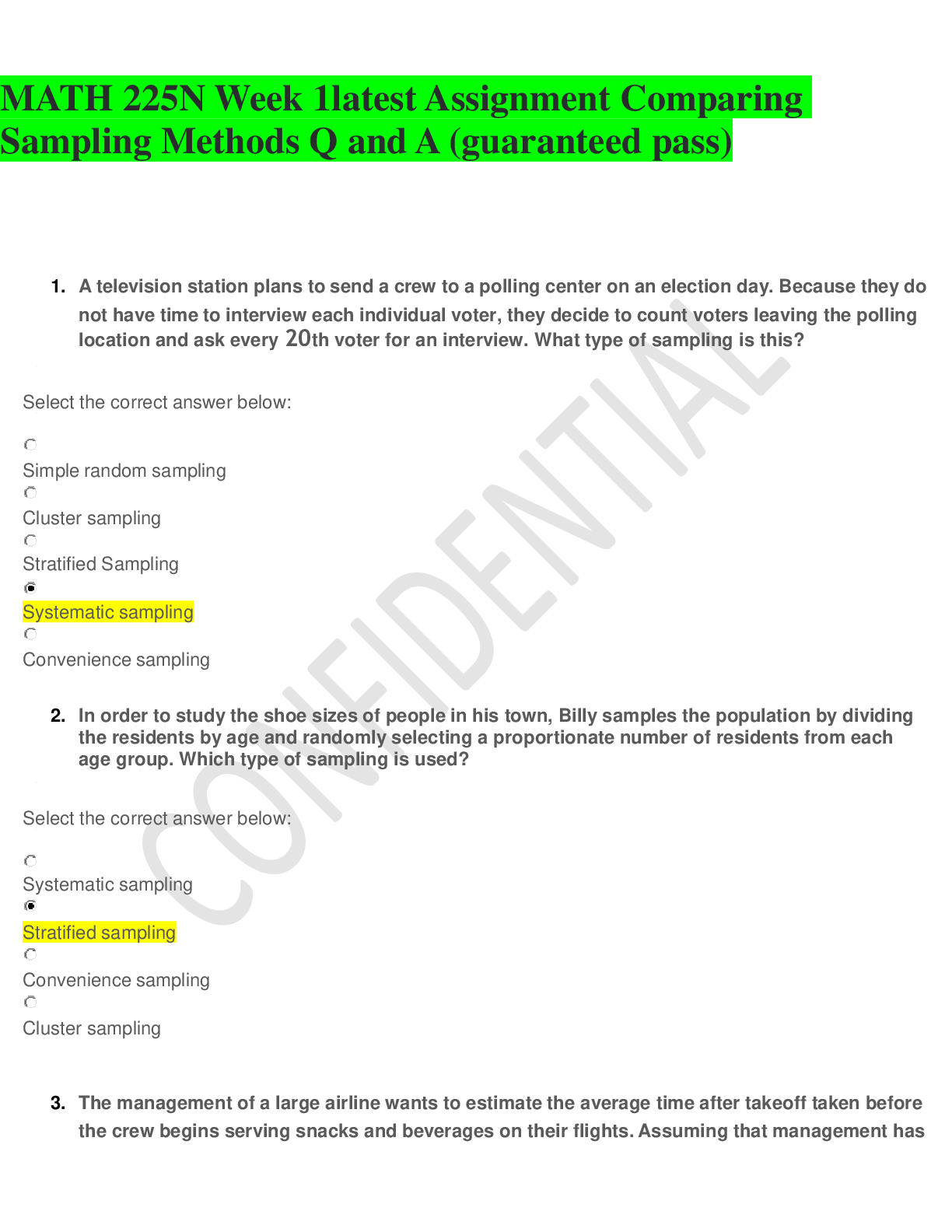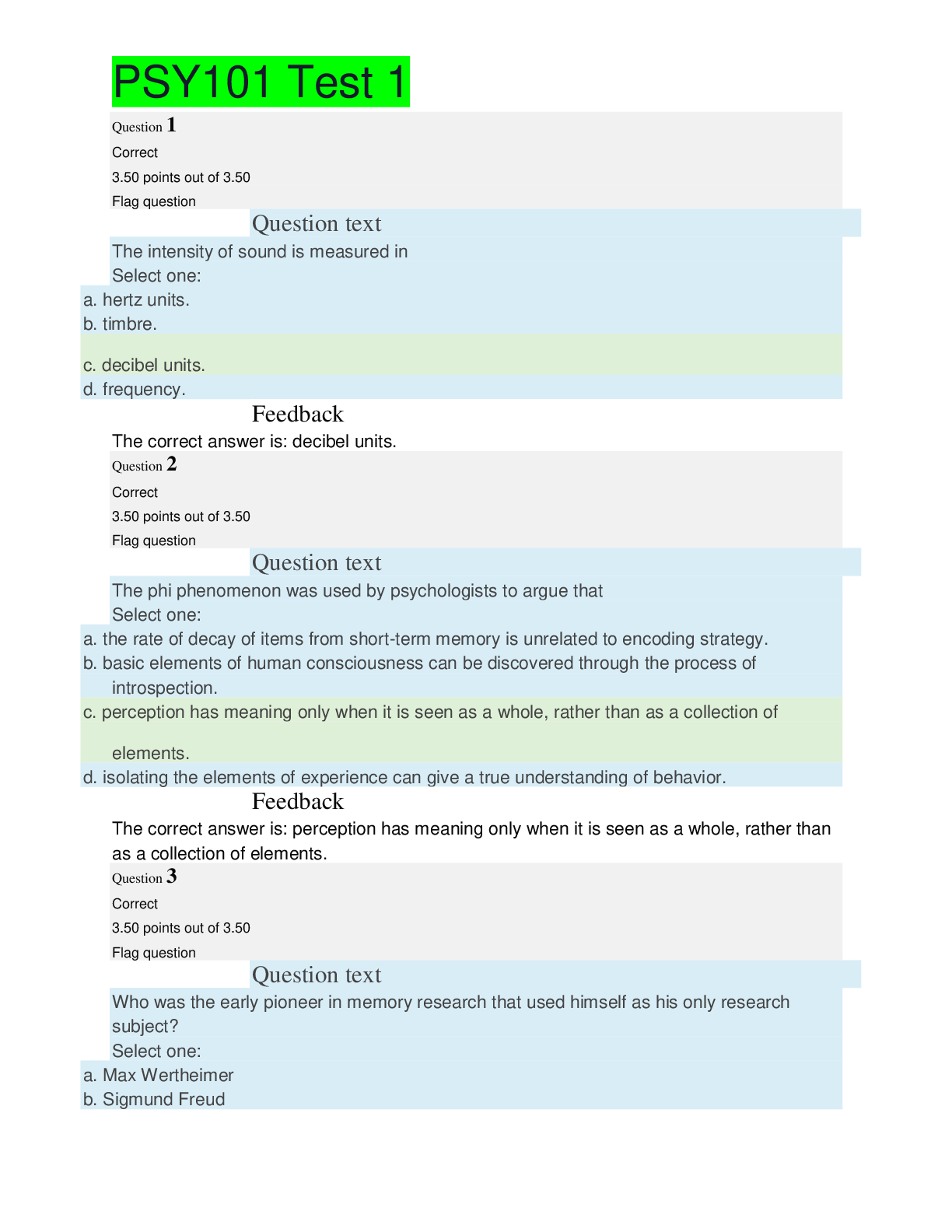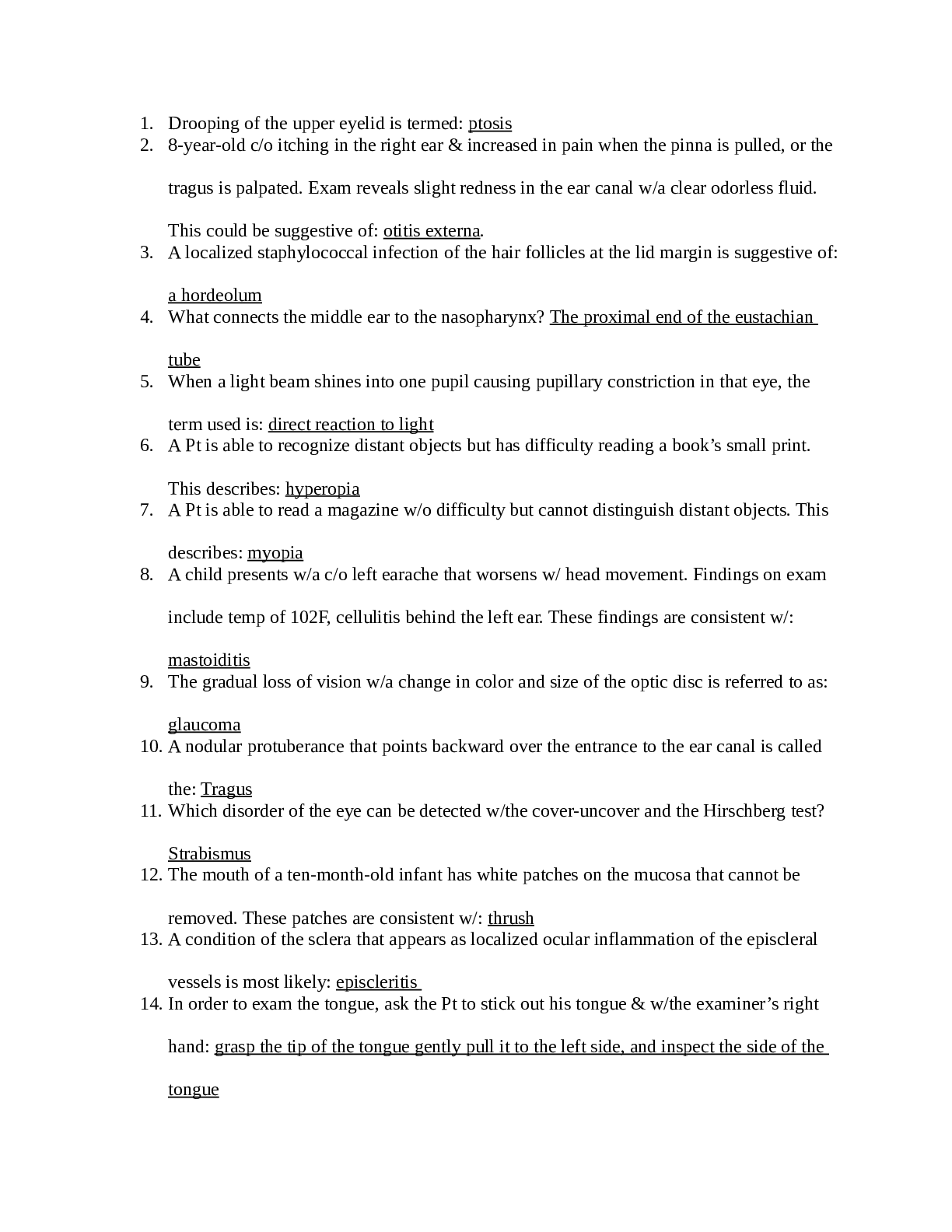*NURSING > EXAM > NURSING NR326 | MENTAL HEALTH (Psychology evolve questions.docx) | 180 Questions plus CORRECT ANSWER (All)
NURSING NR326 | MENTAL HEALTH (Psychology evolve questions.docx) | 180 Questions plus CORRECT ANSWERS with explained rationales | Download To Score A
Document Content and Description Below
Test2 schizophrenia 1. A client with residual schizophrenia is uninterested in community activities. He lacks initiative, demonstrates both poverty of content of speech and poverty of speech, and se... ems unable to follow the schedule for taking his antipsychotic medication. The case manager continues to direct his care with the knowledge that his behavior is most likely prompted by o chronic uncooperativeness. o personality conflict. o neural dysfunction. Correct o dependency needs. Incorrect 2. 2.ID: 45524569 A client with paranoid schizophrenia refuses food. He states the voices are telling him the food is contaminated and will change him from a male to a female. A therapeutic response for the nurse would be o "You are safe here in the hospital, nothing bad will happen to you." o "The voices are wrong about the hospital food. It is not contaminated." o "I understand that the voices are very real to you, but I do not hear them." Correct o "Other people are eating the food and nothing is happening to them." B. 3.ID: 45524582 A client with disorganized schizophrenia would have greatest difficulty with the nurse o interacting with a neutral attitude. o using concrete language. o giving multistep directions. Correct o providing nutritional supplements. C. 4.ID: 45524591 A nursing intervention designed to help a schizophrenic client manage relapse is to o schedule the client to attend group therapy. o teach the client and family about behaviors associated with relapse. Correct o remind the client of the need to return for periodic blood draws. o help the client and family adapt to the stigma of chronic mental illness. Incorrect D. 5.ID: 45524801 A client with paranoid schizophrenia tells the nurse "I have to get away. The volmers are coming to execute me." The term "volmers" can be assessed as o a neologism. Correct o clang association. o blocking. Incorrect o a delusion. E. 6.ID: 45524813 When a client with paranoid schizophrenia tells the nurse "I have to get away. The volmers are coming to execute me," an appropriate response for the nurse would be o "You are safe here. This is a locked unit and no one can get in." o "I do not believe I understand the word volmers. Tell me more about them." o "Why do you think someone or something is going to harm you?" o "It must be frightening to think something is going to harm you." Correct F. 7.ID: 45524824 A desired outcome for a client with schizophrenia who has a nursing diagnosis of Disturbed sensory perception: auditory hallucinations related to neurobiological dysfunction would be that the client will o ask for validation of reality. Correct o describe content of hallucinations. o demonstrate a cool, aloof demeanor. o identify prodromal symptoms of disorder. Incorrect G. 8.ID: 45524833 A client has reached the stable plateau phase of schizophrenia. An appropriate clinical focus for planning would be o safety and crisis intervention. o acute symptom stabilization. Incorrect o stress and vulnerability assessment. o social, vocational, and selfcare skills. Correct H. 9.ID: 45524843 A client has been receiving antipsychotic medication for 6 weeks. At her clinic appointment she tells the nurse that her hallucinations are nearly gone and that she can concentrate fairly well. She states her only problem is "the flu" that she's had for 2 days. She mentions having a fever and a very sore throat. The nurse should o suggest that the client take something for her fever and get extra rest. o advise the physician that the client should be admitted to the hospital. Incorrect o arrange for the client to have blood drawn for a white blood cell count. Correct o consider recommending a change of antipsychotic medication. I. 10.ID: 45524855 The purpose for a nurse periodically performing the Abnormal Involuntary Movement Scale (AIMS) assessment on a persistently mentally ill client who has schizophrenia is early detection of o acute dystonia. o tardive dyskinesia. Correct o cholestatic jaundice. o pseudoparkinsonism. Anxiety Disorder Questions 1. 1.ID: 45516256 The major distinction between fear and anxiety is that fear: A. is a universal experience; anxiety is neurotic. B. enables constructive action; anxiety is dysfunctional. Incorrect C. is a psychological experience; anxiety is a physiological experience. D. is a response to a specific danger; anxiety is a response to an unknown danger. Correct Awarded 0.0 points out of 1.0 possible points. 2. 2.ID: 45516264 The initial nursing action for a newly admitted anxious client is to A. assess the client's use of defense mechanisms. B. assess the client's level of anxiety. Correct C. limit environmental stimuli. D. provide antianxiety medication. 3. 3.ID: 45516273 Selective inattention is first noted when experiencing anxiety that is: A. mild. B. moderate. Correct C. severe. D. panic. 4. 4.ID: 45516284 Delusionary thinking is a characteristic of: A. chronic anxiety. B. acute anxiety. C. severe anxiety. D. panic level anxiety. Correct 5. 5.ID: 45516296 Generally, ego defense mechanisms: A. often involve some degree of selfdeception. Correct B. are rarely used by mentally healthy people. C. seldom make the person more comfortable. D. are usually effective in resolving conflicts. 6. 6.ID: 45516505 A 20yearold was sexually molested at age10 but he can no longer remember the incident. The ego defense mechanism in use is A. projection. B. repression. Correct C. displacement. D. reaction formation. 7. 7.ID: 45516515 The defense mechanisms that can only be used in healthy ways are A. suppression and humor. B. altruism and sublimation. Correct C. idealization and splitting. D. reaction formation and denial. 8. 8.ID: 45516526 Which behavior would be characteristic of an individual who is displacing anger? A. Lying B. Stealing C. Slapping D. Procrastinating Correct 9. 9.ID: 45516538 A person who recently gave up smoking and now talks constantly about how smoking fouls the air, causes cancer, "burns" money that could be better spent to feed the poor, and so forth is using A. projection. B. rationalization. C. reaction formation. Correct D. undoing. 10. 10.ID: 45516547 A man keeps his wife's clothing in the closet and bureau of his bedroom although she has been dead for 3 years. This behavior suggests the use of A. altruism. B. denial. Correct C. undoing. D. suppression. 11. 11.ID: 45516557 What can be said about the age of onset of most anxiety disorders? Onset is A. before age 20 years. B. before age 40 years. Correct C. after age 40 years. D. scattered throughout the lifespan. 12. 12.ID: 45516569 What can be said about the comorbidity of anxiety disorders? A. Anxiety disorders exist alone. B. A second anxiety disorder may coexist with the first. Correct C. Anxiety disorders virtually never coexist with mood disorders. D. Substance abuse disorders rarely coexist with anxiety disorders. 13. 13.ID: 45516580 Studies of clients with posttraumatic stress disorder suggest that the stress response of which of the following is considered abnormal? A. Brainstem B. Hypothalamuspituitaryadrenal system Correct C. Frontal lobe D. Limbic system 14. 14.ID: 45516589 An obsession is defined as A. thinking of an action and immediately taking the action. B. a recurrent, persistent thought or impulse. Correct C. an intense irrational fear of an object or situation. D. a recurrent behavior performed in the same manner. 15. 15.ID: 45516599 A symptom associated with panic attacks is A. obsessions. B. apathy. C. fever D. fear of impending doom. Correct 16. 16.ID: 45516811 Working with a client to help the client view an occurrence in a more positive light is called A. flooding. B. desensitization. C. response prevention. D. cognitive restructuring. Correct 17. 17.ID: 45516822 The primary purpose of performing a physical examination before beginning treatment for any anxiety disorder is A. legal protection. B. to establish nursing diagnoses of priority. C. to provide information about client psychosocial background. D. to determine if the anxiety is of primary or secondary origin. Correct 18. 18.ID: 45516831 An important question to ask in the assessment of a client with anxiety disorder is A. "How often do you hear voices?" B. "Have you ever considered suicide?" Correct C. "How long has your memory been bad?" D. "Do your thoughts always seem jumbled?" 19. 19.ID: 45516841 A possible outcome criteria for a client with anxiety disorder is A. Client demonstrates effective coping strategies. Correct B. Client reports reduced hallucinations. C. Client reports feelings of tension and fatigue. D. Client demonstrates persistent avoidance behaviors. 20. 20.ID: 45516853 Inability to leave one's home because of avoidance of severe anxiety suggests the anxiety disorder of A. panic attacks with agoraphobia. Correct B. obsessivecompulsive disorder. C. posttraumatic stress response. D. generalized anxiety disorder. Eating Disorder 1. 1.ID: 45512489 The client with bulimia differs from the client with anorexia nervosa by A. maintaining normal weight. Correct B. holding a distorted body image. C. doing more rigorous exercising. D. purging to keep weight down. 2. 2.ID: 45512498 A subjective symptom the nurse would expect to note during assessment of a client with anorexia nervosa is A. lanugo. B. hypotension. C. 25lb weight loss. D. fear of gaining weight. Correct 3. 3.ID: 45512707 During assessment of a client with anorexia nervosa it is not likely that the nurse would note indications of: A. introversion. B. social isolation. C. high selfesteem. Correct D. obsessivecompulsive tendencies. Awarded 0.0 points out of 1.0 possible points. 4. 4.ID: 45512718 Biological theorists suggest the cause of eating disorders may be A. normal weight phobia. B. body image disturbance. C. serotonin imbalance. Correct D. dopamine excess. 5. 5.ID: 45512735 A nursing diagnosis for a client who is 16 years old, 5 foot 3 inches tall, and 80 pounds who eats one tiny meal daily and engages in a rigorous exercise program would be A. death anxiety. B. ineffective denial. C. disturbed sensory perception. D. imbalanced nutrition: less than body requirements. Correct 6. 6.ID: 45512743 A coping mechanism used excessively by clients with anorexia nervosa is A. denial. Correct B. humor. C. altruism. D. projection. 7. 7.ID: 45512751 A client reveals that she induces vomiting as many as a dozen times a day. The nurse would expect assessment findings to reveal A. tachycardia. B. hypokalemia. Correct C. hypercalcemia. D. hypolipidemia. 8. 8.ID: 45512762 A client with bulimia nervosa uses enemas and laxatives to purge to maintain her weight. The imbalance for which the nurse should assess is A. an increase in red blood cell count. B. disruption in fluid and electrolyte balance Correct C. elevated serum potassium. D. elevated serum sodium. 9. 9.ID: 45512774 A realistic shortterm goal for the first week of hospitalization for a client with anorexia nervosa whose weight is 65% of normal weight would be: By end of week 1 the client will A. gain a maximum of 3 lb. Correct B. develop a pattern of normal eating behavior. C. discuss fears and feelings about gaining weight. D. verbalize awareness of sensation of hunger. 10. 10.ID: 45512784 Bupropion (Wellbutrin) while seemingly effective is contraindicated in patients who purge because of: A. historically poor patient compliance B. an increased risk in seizures Correct C. long term effects on liver function D. the potential to cause gastric ulcers Suicide 1. 1.ID: 45519553 Which of the following represents the greatest protective factor against the risk of suicide? A. Previous suicide attempt(s) Incorrect B. Sense of responsibility to family (e.g., spouse, children) Correct C. Fear of dying D. Cultural belief that suicide is a shameful resolution for a dilemma 2. 2.ID: 45519563 An assessment tool that is useful to nurses in rating suicide risk is the A. AIMS scale. B. Sad Persons scale. Correct C. CAGE questionnaire. D. MiniMental Status Examination. 3. 3.ID: 45519574 Which statement represents a fact about suicide? A. More women than men commit suicide. B. Suicide is the fourth leading cause of death in the United States. C. Native Americans and Alaskan Natives have low suicide rates. D. A schizophrenic client is at a great risk for attempting suicide. Correct 4. 4.ID: 45519583 A suicidal individual calls a suicide hot line. This represents the level of intervention classified as A. primary. B. secondary. Correct C. tertiary. D. quaternary. 5. 5.ID: 45519593 Which neurotransmitter has been implicated as playing a part in the decision to commit suicide? A. γAminobutyric acid B. Dopamine C. Serotonin Correct D. Acetylcholine 6. 6.ID: 45519704 When working with a client that the nurse thinks may have made a covert reference to suicide, the nurse should A. be careful not to mention the idea of suicide. B. listen carefully to see if the client mentions it a second time. C. ask about the possibility of suicidal thoughts in a covert way. D. ask the client directly if he or she is thinking of attempting suicide. Correct 7. 7.ID: 45519714 Nurses should assess the lethality of the client's plan for suicide. What factor would be irrelevant to that assessment? A. How long the client has been suicidal? Correct B. Does the plan have specific details? C. Is the method one that causes death quickly? D. Does the client have the means to implement the plan? 8. 8.ID: 45519725 The suicide intervention that has the most impact on client safety is: A. informing visitors regarding potential dangerous gifts. B. restricting client from potential dangerous areas of the unit. C. oneonone observation by staff. Correct D. removal of personal items that might prove harmful. 9. 9.ID: 45519735 Some of the most important characteristics that staff, working with suicidal clients, need to have are A. the ability to be consistently organized. B. the ability to teach problemsolving skills. C. warmth and consistency when interacting. Correct D. interview and counseling skills. 10. 10.ID: 45519746 The nurse proposes that a suicidal client enter into a nosuicide contract. Such a contract would contain a provision that the client promises A. never to attempt suicide. B. to alert someone if he or she has made an attempt. C. to not consider suicide for 72 hours. D. not to attempt suicide in the next 24 hours. Correct [Show More]
Last updated: 2 years ago
Preview 1 out of 31 pages

Buy this document to get the full access instantly
Instant Download Access after purchase
Buy NowInstant download
We Accept:

Reviews( 0 )
$13.50
Can't find what you want? Try our AI powered Search
Document information
Connected school, study & course
About the document
Uploaded On
May 12, 2021
Number of pages
31
Written in
Additional information
This document has been written for:
Uploaded
May 12, 2021
Downloads
0
Views
60



 Questions and Answers 100% VERIFIED.png)
 Questions and Answers 100% correct Solutions.png)






.png)

 – Chamberlain College of Nursing.png)
 – Chamberlain College of Nursing.png)
 – Chamberlain College of Nursing.png)







.png)


